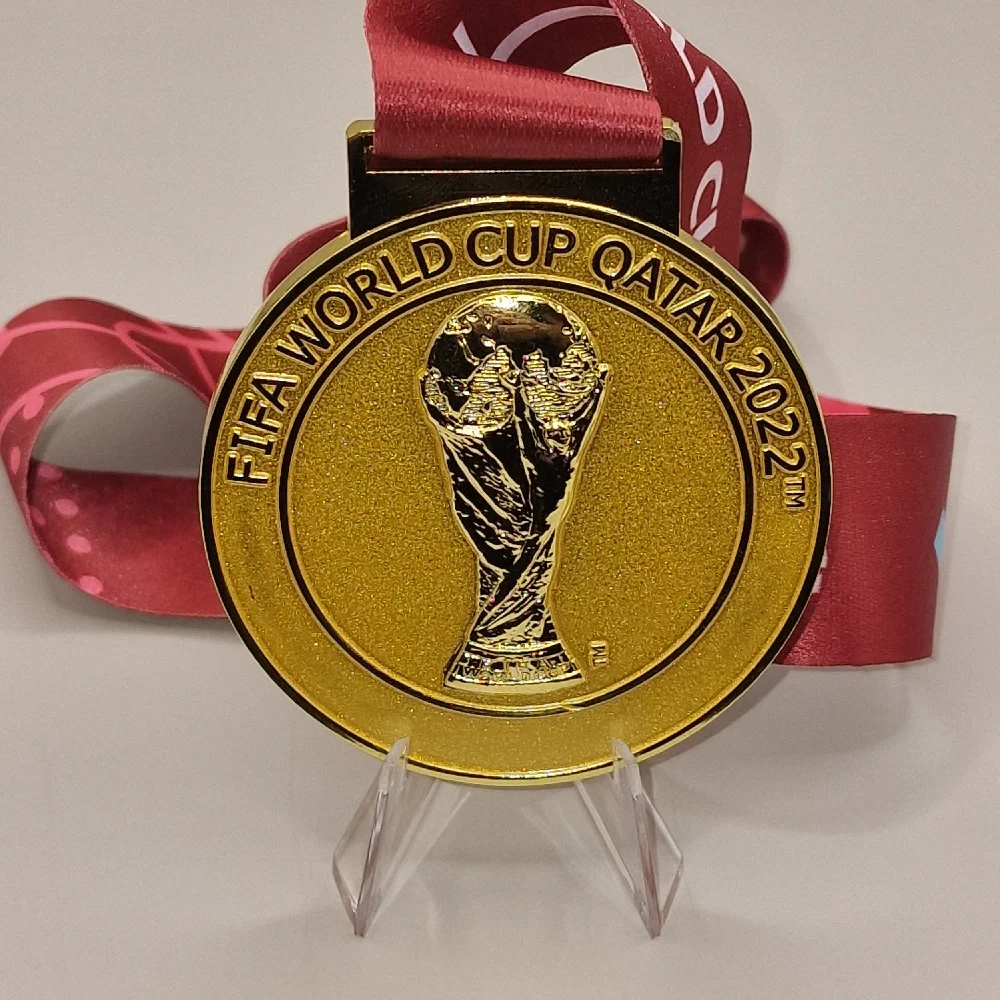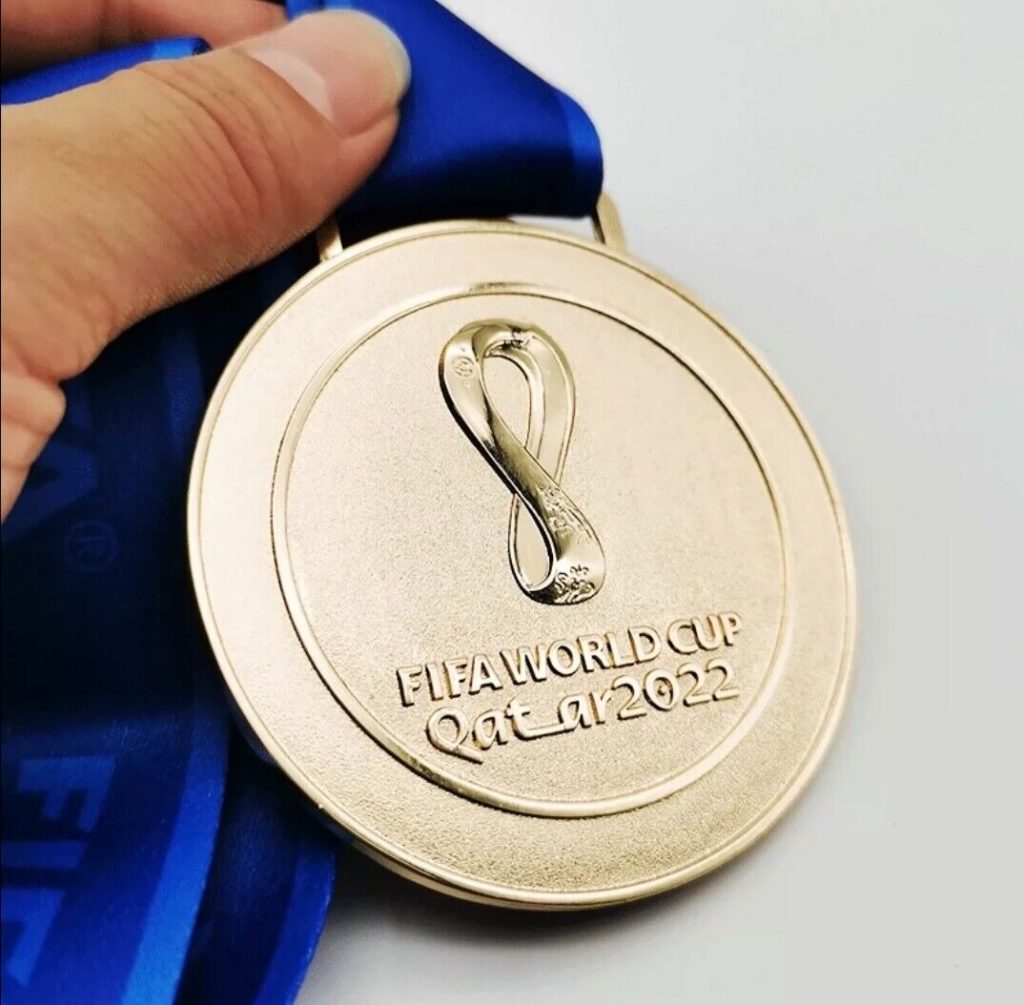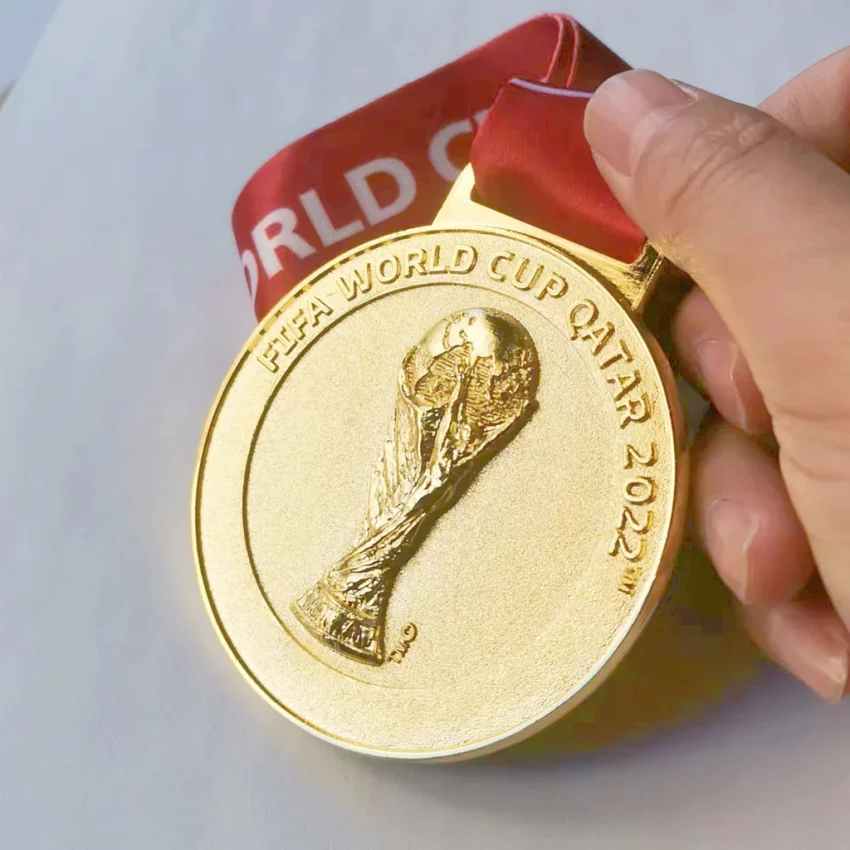No, World Cup gold medals are not made of solid gold. While they bear the name “gold,” they are primarily composed of a silver core with a thin plating of 18-karat gold. This plating gives them their distinctive golden appearance. The decision to use a combination of materials is driven by practicality and cost-effectiveness, as solid gold medals would be prohibitively expensive and less durable.
Despite not being entirely made of gold, these medals hold immense symbolic value. They represent the highest level of achievement in international football, embodying the dreams, dedication, and triumph of the athletes who earn them.
So, while they may not be solid gold, World Cup gold medals are, in the hearts of athletes and fans alike, worth their weight in gold.
What is the Historical Significance of World Cup Medals?

World Cup medals have a rich and fascinating history that has evolved over the years. These iconic trophies represent the pinnacle of achievement in international sports and have become more than just a symbol of victory. The evolution of World Cup medals reflects the changing times, technology, and the significance of the sport itself. Let’s take a journey through the history of these prestigious awards
Early Days
The first FIFA World Cup took place in 1930 in Uruguay. During this initial tournament and the following ones, the medals were relatively simple. They typically featured a design of a globe with the words “FIFA World Cup” and the tournament year. The material used for these early medals was not always gold; some were bronze or silver.
1934 – Italy
The 1934 World Cup in Italy marked the first significant change in medal design. The medals were more ornate and featured the head of a Roman Emperor, likely inspired by Italy’s rich history. These medals were made of bronze and were larger and more detailed than their predecessors.
1950 – Brazil
The 1950 World Cup in Brazil introduced a design that would become iconic. The medals featured a football player kicking a ball on one side and the tournament’s emblem on the other. This design has remained a staple of World Cup medals to this day. The material was typically gold-plated.
1966 – England
The 1966 World Cup in England was a landmark event for medal design. For the first time, the medals featured the Jules Rimet Trophy, which was the original World Cup trophy. The Jules Rimet Trophy was awarded to the winning team until 1970. The medals from this era are highly sought after by collectors due to their historical significance.
1974 – West Germany
The 1974 World Cup introduced a change in the material used for the medals. Instead of gold-plated bronze, these medals were made of solid gold. This move significantly increased the intrinsic value of the medals.
1998 – France
The 1998 World Cup in France saw another shift in design. The medals became more modern and sleek, featuring a contemporary football player on one side. The emphasis on the host country’s cultural and artistic influences was evident in the design.
2006 – Germany
The 2006 World Cup medals maintained a similar design to the 1998 edition, emphasizing the global nature of the sport. The medals were made from a combination of materials, including gold and silver.
2014 – Brazil and 2018 – Russia
In recent tournaments, the design of World Cup medals has become more intricate and visually appealing. They still feature the iconic football player image but with a more contemporary and polished look. These medals are often made from a combination of gold and other precious metals.
2022 Qatar World Cup
In the context of the 2022 Qatar World Cup, the medals held unique significance. They symbolized hope and resilience during the COVID-19 pandemic. Additionally, they signified a desire for progress and change, addressing ethical concerns related to the tournament’s location. These medals carried a profound message of unity and transformation.
How Much Is A Winner’s Medal Worth?
A winner’s medal holds a special place in the hearts of athletes and teams, far beyond its monetary value. It symbolizes the culmination of years of hard work and dedication. Yet, when we do consider the real-world worth, it can be eye-opening. In 2019, France’s 2018 World Cup-winning squad decided to auction their medals for charity. The astonishing part? They fetched an impressive $71,875 or roughly £70,000 today, accounting for inflation.
This sum might seem astonishing to sports enthusiasts, given that these medals represent incredible sporting accomplishments. However, these medals are more than just pieces of metal; they are cherished collector’s items. As time passes, their value is expected to rise even further.
Now, let’s talk about the 2022 Qatar World Cup winners’ medals. Their intrinsic value is estimated to be around $20,000, which considers the gold, silver, and bronze alloy used to craft them. But here’s where it gets interesting – the actual worth of a medal can soar far higher.
Take, for instance, a 2018 World Cup winners’ medal that recently sold for $71,875. This exceptional price is largely attributed to the medal’s connection to a major international sporting event and the fact that it was earned by a member of the highly successful French national team.
So, how much could a 2022 Qatar World Cup winners’ medal go for in an auction? It’s a bit of a mystery and depends on various factors, including the buyer’s interest and the overall demand for such a historic piece. However, given its rarity and historical significance, it’s safe to assume that these medals would likely fetch a substantial sum.
It’s worth noting that many athletes opt to hold onto their winners’ medals, even when offered significant sums of money. The sentimental value and the representation of their peak athletic achievements make these medals truly priceless to the winners.
How Valuable Are World Cup Medals?
When we consider the worth of World Cup medals, it’s essential to look beyond the financial aspect and appreciate the multi-dimensional value these prestigious awards hold. These medals, symbolic of the highest sporting achievements in international football, possess a value that extends far beyond mere numbers or material composition.
Intrinsic Worth
In terms of intrinsic value, World Cup medals do have a monetary estimate. Their composition, typically featuring a silver core with a thin plating of 18-karat gold, places their intrinsic value at around $20,000. However, this value primarily represents the cost of materials and craftsmanship, which is a fraction of their overall worth.
The Historical Significance
World Cup medals are historical artifacts. They encapsulate the journey of international football, commemorating legendary players, iconic goals, and the evolution of the sport itself. As such, they carry a unique historical significance that appeals to sports enthusiasts and collectors. This historical importance elevates their market value, making them prized items at auctions and in memorabilia circles.
Emotional Significance
For athletes who have earned World Cup medals, the emotional value far outweighs any financial assessment. These medals represent the culmination of lifelong dreams, dedication, and unwavering passion. They embody the countless hours of training, the sacrifices made, and the pride of representing their nations on the grandest stage of football. To the players, these medals are priceless symbols of their athletic journey.
The Rarity Factor
World Cup medals are scarce by nature. With only a limited number awarded during each tournament, they remain in high demand among collectors and football enthusiasts. This rarity contributes significantly to their market value, creating a competitive market for these historic prizes.
The Human Element
From the perspective of the athletes, World Cup medals are immeasurably valuable. They signify more than just a sporting achievement; they represent the heart and soul of the beautiful game. These medals carry the dreams, aspirations, and sweat of the players who wore their national colors with pride. They are a testament to the indomitable human spirit and the unbreakable bonds forged on the football pitch.
Notable World Cup Medal Moments

The FIFA World Cup has provided the world with countless memorable moments in the realm of sports, where athletes etch their names into history.
Pele’s Hat-Trick (1958): In the 1958 World Cup final, a 17-year-old Pele scored a hat-trick for Brazil, becoming the youngest player to achieve this feat in a World Cup final. This remarkable performance led to Brazil’s first World Cup victory.
The ‘Hand of God’ and the ‘Goal of the Century’ (1986): Diego Maradona, in the quarter-final match between Argentina and England, scored two of the most iconic goals in World Cup history. The first was a controversial goal that he famously referred to as the “Hand of God,” while the second, a mesmerizing solo run past several English players, was hailed as the “Goal of the Century.”
Zidane’s Headbutt (2006): In the 2006 World Cup final, French football legend Zinedine Zidane stunned the world by headbutting Italian defender Marco Materazzi. This moment of madness, during what would be Zidane’s final professional match, remains one of the most unforgettable and controversial incidents in World Cup history.
The German Wall (1990): West Germany’s goalkeeper, Bodo Illgner, put on a remarkable display during the 1990 World Cup final against Argentina. His outstanding saves were instrumental in securing West Germany’s victory and earning him a well-deserved medal.
Brazil’s Redemption (2002): In the 2002 World Cup final, Brazil faced Germany, seeking redemption after their devastating loss to Uruguay in the 1950 final. Ronaldo, who had struggled with injuries in the past, scored both of Brazil’s goals, leading his team to victory and securing his place as one of Brazil’s all-time greats.
Geoff Hurst’s Hat-Trick (1966): Geoff Hurst became a legend in English football by scoring a hat-trick in the 1966 World Cup final against West Germany. England’s 4-2 victory in extra time marked their first and only World Cup win.
Cannavaro’s Heroics (2006): Fabio Cannavaro, the Italian captain, led his team to victory in the 2006 World Cup. His incredible defensive skills and leadership were instrumental in Italy’s triumph.
FAQ
Which cup is the richest?
The FIFA World Cup is often considered the richest in terms of global viewership and sponsorship deals.
Which medal is real gold?
Medals with a gold appearance are typically gold-plated, not made of solid gold.
What is the rarest medal to get?
The rarest medal to earn is often considered the Olympic gold medal due to the intense competition and high standards required to achieve it.
What is the rarest medal in history?
The rarest medal in history would likely be one-of-a-kind or specially commissioned medals, but such cases are exceptional.
How many countries have never won a medal?
Numerous countries have never won a medal in various international competitions, depending on the sport and event.
Has a gold medal ever been sold?
Yes, gold medals have been sold at auctions, especially those with historical significance, fetching substantial sums of money.
What countries have never won a medal?
Many countries, especially smaller or less-developed ones, have never won medals in major international competitions due to the intense competition from larger, more established nations.
Final words
In conclusion, World Cup medals are not purely made of solid gold, but they hold a value that goes beyond their material composition. These medals are a symbol of hard work, dedication, and the pursuit of excellence on the global sports stage. They capture the spirit of competition, unity, and the love of the game. While their intrinsic value is based on the metals they’re made of, their true worth is immeasurable. To athletes and fans, they are priceless reminders of extraordinary achievements and the enduring power of the beautiful game. So, whether gold, silver, or bronze, these medals will forever shine as beacons of sporting glory.

